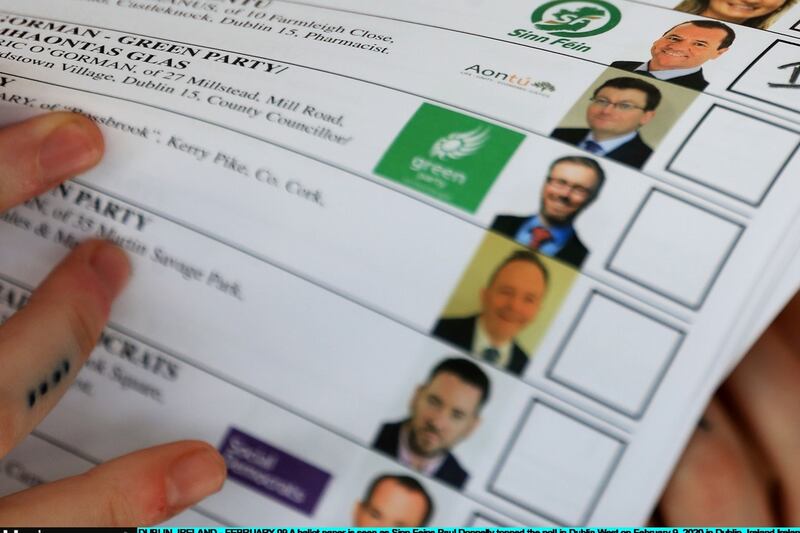One of the outcomes of the 2020 general election is that it poses – and in some ways answers – questions about the impact of the social revolution in Ireland emerging from the marriage equality and Repeal movements. The disruption of electoral politics through gains made by Sinn Féin and other left-wing candidates, can be framed as a continuation of an electorate’s intent on moulding the political landscape of the country in its own vision. This is a fluid process, which is unpredictable, but in which change will continue to be a constant.
In June 2018, I wrote that Sinn Féin would be a beneficiary of the Repeal movement, as it emerged from the referendum as the only large party with a woman leader, primed to capture female voters and new middle-class voters for whom Gerry Adams was fast becoming a memory. But the impact of the Repeal movement in particular, which was larger than the marriage equality movement simply because reproductive rights impact more people in Ireland than marriage rights for same-sex couples, will perhaps have a larger legacy that is difficult to quantify. What we can reflect on at this point is the political engagement of younger people, and the ideals that underpinned the movement – solidarity, equality, progress, empathy – and the focus on issues rather than traditional party loyalties, contributed to the election outcome.
This election was no doubt coloured not just by the desire for change, but also an electorate being able to conceptualise the possibility for change because of how much Irish society has changed in the past five years or so. The election was a continuation of that change.
Female politicians
Within the election results is the paradox of some high-profile female politicians losing their seats, with many people pointing to Ruth Coppinger, who had a high profile in the Repeal movement. Why, if the Repeal movement was so successful, were some of its architects and participants not rewarded come election time? Yet people weren’t necessarily casting a pro-choice vote during this election, because they had already done that in 2018. The Repeal effect is more nuanced than a blunt reward system. Movements and politicisation born from grassroots activism and protest are always going to colour people’s politics in a very particular way. In some ways, it creates a lack of fear regarding change. Why play safe when goals that were perceived as radical were achieved? The electorate may have found themselves asking what’s next. The answer to that is this election outcome.
It creates a lack of fear regarding change. Why play safe when goals that were perceived as radical were achieved?
All elections are different, but this one sits firmly outside of the norm, and so the results are going to be unusual in many ways. How can we account for Eoghan Murphy keeping his seat and Kate O’Connell – a dominant personality during Repeal – losing hers, for example? Or Jack Chambers, one of the worst media performers of the election, who also opposed the repeal of the Eighth Amendment, keeping his seat? There are multiple reasons, and many are to do with how the Fine Gael and Fianna Fáil votes respectively were ring-fenced in both constituencies.
This was not a great election for women. Achieving gender parity in areas traditionally dominated by men is hard. When it is initially tackled in a serious way, there are often large leaps, inevitably followed by smaller incremental gains. The work is never “finished”, and the structures and systems have to themselves have change, and the maintenance of that change become embedded in their design, such as gender quotas. Mandatory gender quotas for candidates would have a faster impact than merely incentivising or de-incentivising political parties.
Gender balance
In total, 162 of the 531 candidates who ran were women, which is 31 per cent. In the last government, 35 deputies were women, a 22 per cent share, which was a 40 per cent increase from the 2011 election. This time, 36 women were elected. While there were plenty of women who lost their seats, that is an increase, albeit an unacceptably small one for many. This modest growth was also a characteristic of the local elections in 2019, when Dún Laoghaire-Rathdown became the first local authority in the State to have a gender-balanced council, yet elsewhere, less than a quarter of councillors elected across the country were women. The 2020 election was also the first time that every constituency had a female candidate running. It’s slightly deflating that it has taken us this long for that to be the case, but that did eventually happen.
The legacy of Repeal and the marriage-equality movement is embedded in Irish society and the psyche of the electorate
There was no impactful concerted campaign to unseat politicians opposed to women’s reproductive rights, and nor was there an impactful campaign to elect those who support them. That doesn’t mean those weren’t things voters were or weren’t bearing in mind. The fact is, the Eighth Amendment has been removed from the Constitution, and voters have moved on to other things, although the legacy of that movement and of the marriage-equality movement is embedded in Irish society, in the psyche of the electorate, and in the politicisation of young people, particularly younger women (18-24), whose turnout for the 2018 referendum vote increased by 94 per cent compared to the 2016 general election. You can’t have engagement so huge as illustrated by that figure, and not have an impact on electoral politics, it just may not be the impact we perceive, or can clearly presume, or identify, but it is there.













